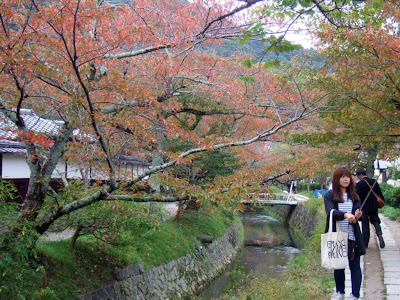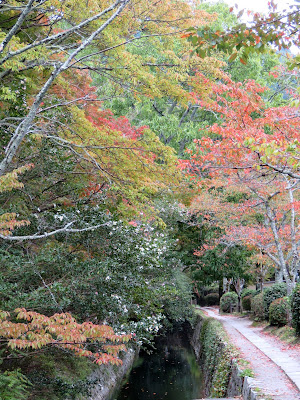
Tetsugaku no Michi is a two meters long stone paved pathway that runs along with a canal. It is widely and commonly known as Philosophy's Path as it was said that Japanese famous Philosopher Nishida Kitaro (1870-1943)while on his daily routine commute to Kyoto University, used to practice his walking meditation along this route. The path begins from Ginkaku-ji Temple and ends at Nanzen-ji Temple.



Shishigatani Canal is part of the Lake Biwa Canal that tunnels through mountains to Lake Biwa nearby Shiga area for a distance of 20 km. It was used to power Japan's first hydro-electric power plant. The canal when first built in Meiji period was to revitalize the local slow moving economy. The Aqueduct arched bridge at Nanjen-ji Temple ground is the continuation of the canal.


Philosophy's Path is one of the most popular Hanami cherry blossom spots in city. Both sides of the walking lane are lined up with hundreds of cherry trees which explodes with colors and blossoms with flowers in early April, making the pedestrian walkway into a romantic path.


Walking along Tetsugaku no Michi at northern end of Higashiyama District at this less peak season is indeed a pleasant and comfortable stroll.



Along the path, there are few galleries with craft shops, boutique and cafe. We stopped by to share a happy Halloween moment with the beautiful young stall owners.



The beautiful autumn leaves that brighten up the canal and the path.




It is also a pleasant sight in fall when leaves begin to turn red !



Canal is home to many carps which are so huge in size.


When the path is not thronged with too many tourists, it belongs to artists, allowing them to possess a serene moment to sit there, admire the sight and sketch them into their drawings.



All to your own!






Most of the buildings along the path nested in the woods are private homes



While entering into the dark entrance of Honen-in, we were attracted by piles of fungus attaching to the grounds or on the rotten wood or root, unique and beautiful.


The secluded Honen-in sitting at the foot of Nyoigadake Mountain, is a hidden treasure along the philosophy's path. The thatched Gate which is sometimes covered with green moss looks extraordinary. This supposed to be the only one in the area to have its gate designed with no doors.


I believe that when the ground of the cozy thatched gate once shaded into colors by the surrounded maple trees, would definitely turn into one of the most magnificent foliage sight in Kyoto.


Honen Temple is renowned for its white sand mounds with designs known as Byakusadan. They appear on both side of the entry path after stepping in from the thatched gate. Byakusadan are said to purify one's body and soul. It replaces the purifying basin usually placed at the entrance or by the side of a Japanese Temple.


The perfectly maintained sand mounds are created by monk in every 3-4 days. The monk usually arrange the sand with various designs early in the morning. Sometimes he shapes them into water waves sometimes flower pedals or plant leaves. The patterns are gorgeous and artistic.



Honen-in was founded in year 1680 to honor Master Honen (1133-1212) who was the founder of Japan Jodo Sect Pureland Buddhism. It was the site where the master made a thatched hut for Buddhists training. The place was left abandoned after he passed away until 400 years later, Rev. Bambu initiated to build a temple on the ruin site and his disciple Rev. Nincho was assigned to follow up with construction.



The Lecturer Hall located to the right of the entrance, is the venue where interesting art exhibits and mini musical concerts are held. The Abbot Shinsho Kajita after the death of his father, became the head monk of the temple in 1984. Under his lead, the temple becomes one of the individuals that invites and brings in many national top artists and intellectuals. Each year it organizes more than 100 events. At our time of visit, works and excellent pictures of some top photographers were in the exhibits. Further down the Lecturer Hall over the bridge, there is a small spring called Zenki-sui. It was said that when Rev. Nincho speared the ground, water burst out and continues flowing until today.



Within the refreshing and calm precincts, there is a 13-tiers stone carved pagoda with a little white Kura storehouse that used for storage purposes in the past. Both structures are gorgeous



Times seem to slow down when wandering in place where nature and structures were set and merged harmoniously. The little water pond that effectively reflected its surrounding objects with its lotus leaves is so lovely.



Main Hall that enshrines one of the most sublime black seated image of Amida Nyorai with wooden images of Master Honen and Rev. Bambu, was only opened twice a year during early April and November. Opposite the Main Hall, stand a figure of Monk Nincho that was made into an image of Jizo Bodhisattva Earth Store. He was enshrined in a grotto against the hill.


The moss covered garden.


Short distance to Honen-in is a permanent resting place for many Japaneses historical personnel and literary scholars like novelist Junichiro (1886-1965), who had spent part of his life in Kyoto.



There are few small temples like this for the stroller to discover along Philosophy's path.



No comments:
Post a Comment